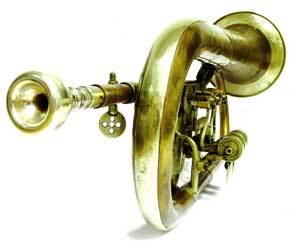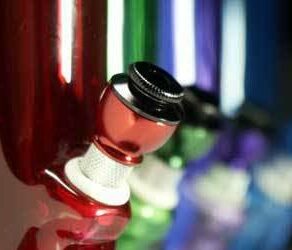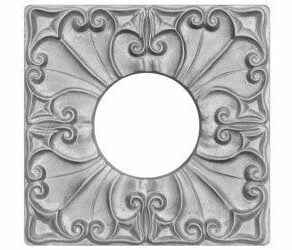
Brass has a very attractive color, luster and finish. But it gets soiled very quickly. Any contact with acid or continuous contact with moisture will cause patina to form on the surface.
How to Care For Brass
What You Will Need:
- Mild detergent
- Warm water
- 2 Buckets
- Clean soft cloths
- Lacquer (optional)
- Old toothbrush
- Rubber gloves
The Cleaning Process:
- Determine if your brass really needs to be cleaned. Sometimes the patina that forms can add character to a piece.
- If you decide that you do want to clean your brass piece, begin by mixing a small amount of mild detergent with warm water in the first bucket and filling the second bucket with plain warm rinse water.
- Moisten the cloth in the water and wipe away any dirt build-up from the brass.
- Use the toothbrush to remove dirt from hard to reach places.
- Moisten a second cloth with the plain rinse water and wipe away all soap residues. You may need to repeat this step several times.
- Rub with a dry cloth to restore the original shine and luster.
- Without protection, tarnish will quickly return with any moisture from the air. To prevent this, apply a lacquer finish to provide a barrier and protect the brass.
- Follow the instructions on the lacquer container for proper application and buffing.
How to Remove Tarnish from Brass
What You Will Need:
- Newspaper
- Paint/Varnish Remover
- Paint brush
- Cotton balls
- Lacquer
- Vinegar
- Stainless steel pot
- Soft cloths
- Brass polish
- Rubber gloves
The Cleaning Process:
- Wash away surface dirt and grime with a mild dish detergent and rinse away.
- Before you can remove the tarnish, you may need to remove the lacquer.
- Spread out newspaper to cover your work area.
- Lay the brass piece on top of the newspaper. Be sure there is plenty of paper underneath to absorb any dripping remover.
- Using the paintbrush, apply the paint or varnish remover evenly over the brass item.
- Use caution and follow all manufacturers’ directions as these products can be dangerous. Wear rubber gloves to protect your hands, work in a well ventilated area and keep away from flames as these products are highly flammable.
- Wipe away the paint or varnish remover with a soft cloth following the directions on the container.
- Now that the lacquer is removed, you can polish the brass. Begin by applying the brass polish with a clean cloth and rub it into the brass.
- Use a second clean cloth and rub off polish and buff item a brilliant shine.
- If tarnish is stubborn and not easily removed, try the following steps.
- Fill a pot with vinegar and bring to a boil. Do this in a well ventilated area as the fumes are very strong!
- When the vinegar is boiling, place the brass item in it. The acid in the vinegar will remove the tarnish. It is normal for it to turn a reddish color, just polish this away with a clean cloth.
- When all tarnish and build up is removed from the piece, it is time to reapply the lacquer.
- Use a cotton ball or paintbrush to apply lacquer according to the manufacturer’s instructions. You will want a thin layer. Watch for any drips that may form and wipe them away before they dry.
- Allow the brass piece to dry thoroughly before touching.
- When it is dry, you can shine it with a clean cloth.
Additional Tips and Advice
- The oils in our skin react with the brass and turn its color in course of time. So if you want to retain the natural color of a brass surface, do not touch it with bare hands.
- It is better not to use any strong chemical or abrasive for cleaning brass because they will destroy the finish and the original shine. Abrasives will leave fine scratches which will tarnish faster.
- Do not use substances like Muriatic Acid. It not only leaves stains on the brass surface, it also produces dangerous fumes.
- Olive oil slows the formation of tarnish. So if brass is rubbed with a cloth moistened with olive oil after each polishing, brass will look brighter for a longer period of time.
- Brass polish is abrasive so be mindful not to scrub off delicate engravings.
- If you’re not sure that your item is really made of brass, use the magnet test. If a magnet sticks then it is not brass.







I am looking for the right way to clean turned brass parts with oil and burr using vinegar.
There are spray cleaners specially designed for brass chandeliers. Simply lay the chandelier on top of newspaper (to catch any drips) and spray it on. Wipe off with a clean cloth. These sprays can be found at most stores where high quality lighting is sold. They may even be available at home improvement stores.
I have an antique stained glass fire screen that has a rather massive brass frame. It is badly tarnished. In fact, I have had it for forty years and it has never been cleaned. It would be beautiful if it were shining! However, I am worried that cleaning it would destroy the patina and thus reduce its antique value. Any suggestions?
I bought a badly tarnished brass candle holder for $1 so I could experiment with it. I read that ketchup would work, so I put the candle holder in the sink and squirted ketchup all over it and left it for about 10 minutes. I got an old tooth brush and scrubbed it real good and rinsed it off. When I looked at it, I could not believe how great it looked. There were a few places that needed a second dose, so I did it again. Once I had rinsed off the second helping and dried it, I was holding what looked like a brand new candle holder. It was quick and easy!!
If I use the vinegar cleaning method, would it harm the enamel on the brass? I’m dealing with old Orthodox brass icons with enamel.
This is my worry.
I’m trying to clean massive, old, copper pots and big, flat trays that are about one meter in diameter. Any suggestions, please?
I am working on cleaning my third chandelier. They are heavily tarnished. I have been using brass cleaner. Most of the tarnish has came off. I am now looking for other ways to finish taking the tarnish off. Should I spray it when I am done?
Thanks for your help! 🙂
Dawn
I have a brass lamp and oil has dripped on it. It has marks on top, which have dripped down and now it is discolored. I want to get rid of these dripping marks, but don’t know what to use – any suggestions? I wonder if I can spray brass paint over it? Please help…Thanks, Trudy
Check it out! We’ve answered your question!
I have a very old chandelier. How do I put a patina on brass paint?
Just a comment on the magnet test:
If the magnet sticks, it doesn’t mean the item is not brass. It’s more likely that the item is brass plated steel – so you shouldn’t use any abrasives (i.e. brass polishes, commercial and homemade) as the very thin plating will be rubbed away, destroying the look.
Try using a chemical method (ketchup?), which should remove the tarnish and leave the (thin) layer of brass plate intact. Note that if the tarnish has gone through the brass plating, your only option is to have it re-plated.
Any help gratefully received.
I bought a super king size brass bed on ebay. I have done the magnet test and it would appear that it is fully brass (not plated). The bed had quite a nice ‘old worldy’ look about it, but I wanted to make it shiny.
I have spent hours cleaning the bed. I used ‘Brasso’ and plenty of elbow grease. After scrubbing each bit, eventually the dirt becomes liquid, but is then a real pain as it goes on the cloth and makes it black. It requires serious elbow grease.
I have finished half the bed and decided to give it a rest for a while whilst I figure out a less time consuming method.
Would I be better off cleaning the remaining brass using water and detergent first, before using Brasso, or would that be ineffective? Or would a non-scratch more ‘heavyweight’ cleaning pad be more effective? Or do I have to spend hours using Brasso, like I have done already?
Cheers
Believe it or not, use ketchup!!
I acquired an antique Art Nouveau dust/crumb pan and brush. There is a black stain on the pan from residual adhesive from a price sticker that wasn’t noticed until it was unwrapped at home. Is there a way to clean this or is it a permanent stain?